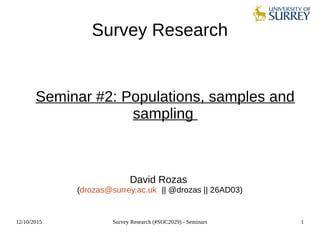Survey Research (SOC2029). Seminar 2: populations, samples and sampling
- 1. 12/10/2015 Survey Research (#SOC2029) - Seminars 1 Survey Research Seminar #2: Populations, samples and sampling David Rozas (drozas@surrey.ac.uk || @drozas || 26AD03)
- 2. 12/10/2015 Survey Research (#SOC2029) - Seminars 2 Outline ŌŚÅ Introduction and quick recap ŌŚÅ Group discussion (A): key concepts ŌŚÅ Class discussion (B): critical discussion of sampling strategy ŌŚÅ Q&A
- 3. 12/10/2015 Survey Research (#SOC2029) - Seminars 3 Quick recap: population vs sample ŌŚÅ Population: the universe of units from which the sample is to be selected ŌŚÅ Sample: segment of the population selected Source: https://upload.wikimedia.org/wikipedia/commons/c/c4/Systematic_sampling.PNG
- 4. 12/10/2015 Survey Research (#SOC2029) - Seminars 4 Probability vs non-probability sampling ŌŚÅ Probability sample: ŌĆō Sample selected randomly ŌĆō Aims to keep sample error to a minimum ŌŚÅ Non-probability sample: ŌĆō Sample not selected with a random selection method ŌĆō Some units more likely to be selected
- 5. 12/10/2015 Survey Research (#SOC2029) - Seminars 5 Probability sampling: some methods Source: https://en.wikipedia.org/wiki/File:Simple_random_sampling.PNG Simple random sample (SRS): each unit has an equal probability Systematic sample: select at intervals, given a random start Source: https://en.wikipedia.org/wiki/File:Systematic_sampling.PNG
- 6. 12/10/2015 Survey Research (#SOC2029) - Seminars 6 Probability sampling: some methods Stratified random sampling: organised by strata (e.g.: department), then randomly selected Source: https://en.wikipedia.org/wiki/File:Stratified_sampling.PNG Source: https://en.wikipedia.org/wiki/File:Stratified_sampling.PNG Multi-stage cluster sampling: primary unit is not the population, but the groups. For example: universities first, then SRS for each of them
- 7. 12/10/2015 Survey Research (#SOC2029) - Seminars 7 Non-probability sampling: some methods ŌŚÅ Convenience sampling: based on relative ease of access ŌŚÅ Snowball sampling: existing study subjects recruit future subjects from among their acquaintances ŌŚÅ Quota sampling: according to certain categories, but not random!
- 8. 12/10/2015 Survey Research (#SOC2029) - Seminars 8 Working in groups (A): key concepts ŌŚÅ Groups of 4 people max ŌŚÅ 15-20 min. discussion per group ŌŚÅ Discuss with all the class
- 9. 12/10/2015 Survey Research (#SOC2029) - Seminars 9 Working in groups (A): key concepts ŌŚÅ Work in groups: could you identify and discuss some of the key concepts from the lecture with regard to the design of a survey for this case study? For example: ŌĆō What would be the population? ŌĆō What type of sampling strategy would you use: probability or non-probability? More specifically (e.g. Simple random sample, stratified random sampling, ŌĆ” or combination of several)? Why?
- 10. 12/10/2015 Survey Research (#SOC2029) - Seminars 11 Working in groups (B): critical discussion ŌŚÅ For each group: ŌĆō Could you discuss the sampling strategy you decide to use? ŌŚÅ Could you identify the possible limitations in your strategy or the ones proposed by other groups? For example: ŌĆō Might another strategy have been more appropriate? ŌĆō Could another sampling strategy have lead to different results?
- 11. 12/10/2015 Survey Research (#SOC2029) - Seminars 12 That's all! Questions? Thanks! Danke! Grazie! ┬ĪGracias! Obrigado! This work is licensed under a Creative Commons Attribution-ShareALike 4.0 Unported License excerpt if otherwise noted. To view a copy of this license, please visit: http://creativecommons.org/licenses/by-sa/4.0/ contact: ŌŚÅ drozas@surrey.ac.uk || www.davidrozas.com ŌŚÅ @drozas











